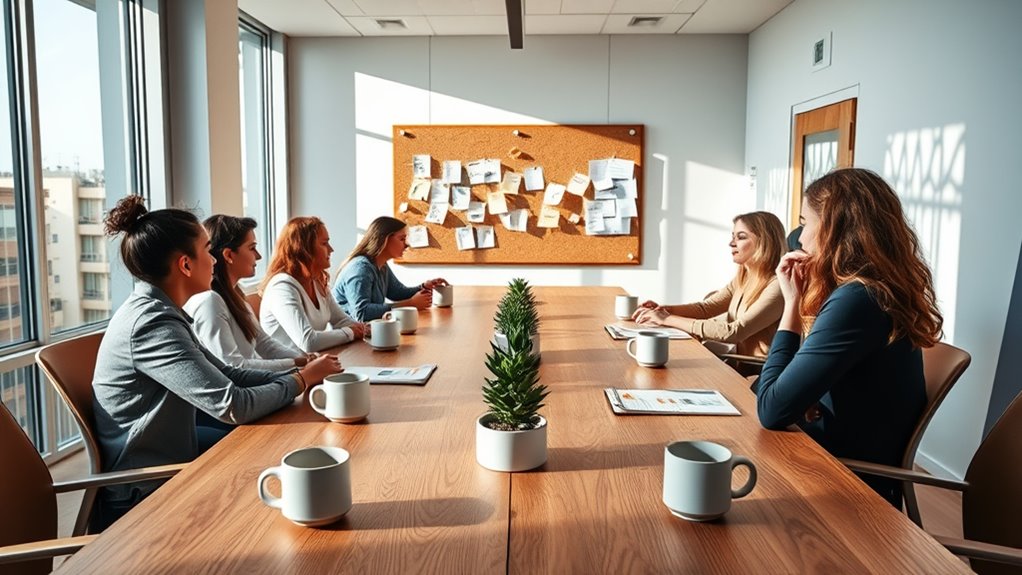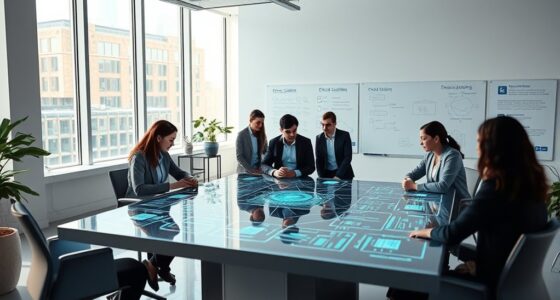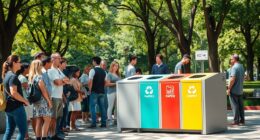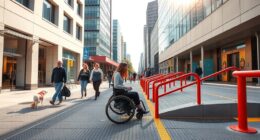You can run zero waste workshops without sticky notes by leveraging digital collaboration tools like cloud-based whiteboards, mind maps, and shared documents to capture and visualize ideas. Facilitate inclusive participation through virtual breakout rooms, polls, and chat features, ensuring everyone’s voice is heard. Focus on eco-friendly materials and structure sessions to promote sustainability. For innovative approaches and tips on creating engaging, waste-free ideation sessions, keep exploring these sustainable strategies further.
Key Takeaways
- Utilize digital whiteboards and collaboration tools for real-time idea sharing, eliminating the need for physical sticky notes.
- Incorporate virtual breakout rooms and shared online documents to facilitate inclusive, paperless brainstorming sessions.
- Use digital sketching apps with layers and colors to capture and refine ideas without physical materials.
- Establish clear, digital agendas and success metrics to guide sustainable, waste-free workshops.
- Promote inclusive participation through online polls, chat features, and round-robin discussions to engage all attendees without paper.
Rethinking Traditional Workshop Tools and Materials
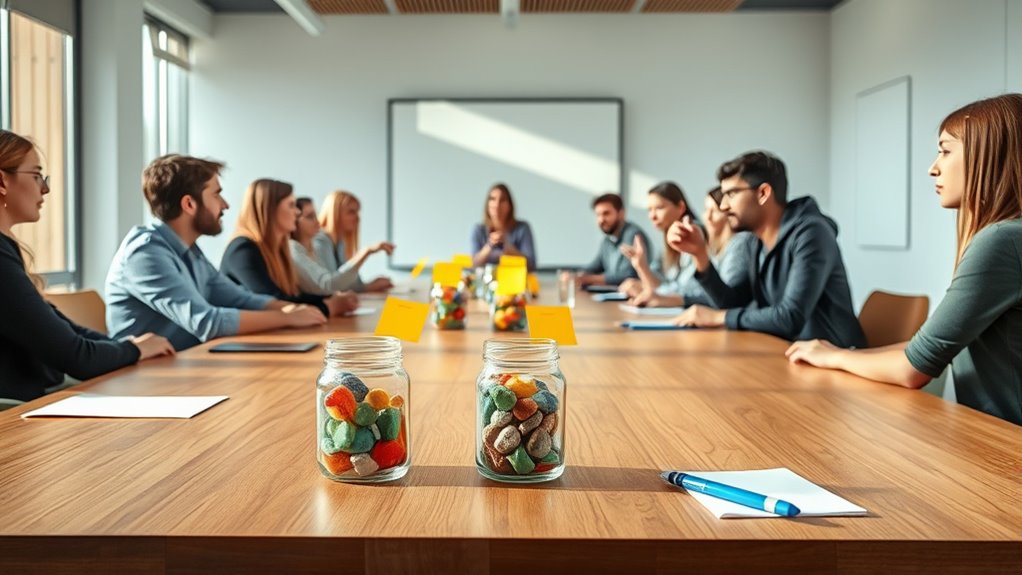
Traditionally, workshops rely heavily on single-use tools and materials that generate waste and harm the environment. To reduce this impact, you can start rethinking your choices by opting for sustainable materials. Use reusable notebooks, pens, and markers instead of disposable ones. Consider eco-friendly alternatives like bamboo or recycled paper for handouts and flip charts. Avoid plastic or non-biodegradable items whenever possible. Instead, choose biodegradable or compostable options for any materials that must be discarded. This shift not only minimizes waste but also encourages participants to adopt environmentally conscious habits. By integrating sustainable materials, you foster a culture of eco-awareness and demonstrate your commitment to sustainability. Incorporating environmentally conscious traits into your planning can further enhance the sustainability of your workshops. Rethinking tools and materials is a vital step toward making your workshops truly zero waste.
Digital Collaboration Platforms for Seamless Idea Sharing
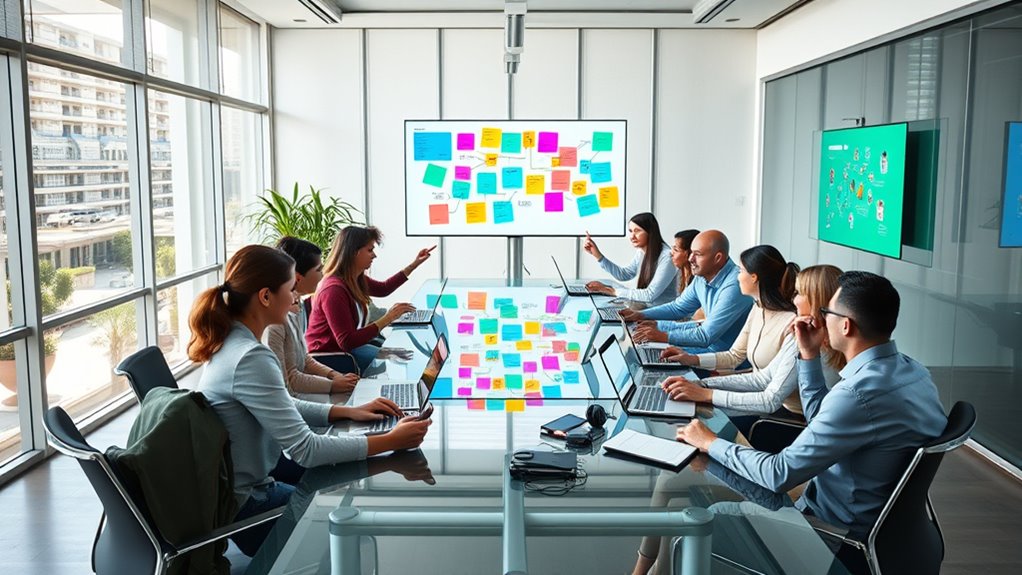
Digital collaboration platforms are transforming how workshop participants share ideas and work together, making the process more efficient and eco-friendly. With cloud-based collaboration tools, everyone can contribute simultaneously, eliminating the need for physical materials like sticky notes or printed charts. These platforms facilitate real-time brainstorming, allowing participants to add, edit, and organize ideas instantly. You can visualize concepts through digital whiteboards or mind maps, which stay accessible to all members, no matter their location. This seamless sharing encourages diverse input and keeps the session dynamic. Plus, it reduces waste and minimizes the environmental impact of traditional workshops. By leveraging these technologies, you create an inclusive, engaging, and waste-free environment that fosters innovation without the need for paper or physical tools. Additionally, understanding residency requirements and legal procedures can help ensure your workshop aligns with organizational or legal guidelines when collaborating across different regions.
Facilitating Engagement Without Paper or Sticky Notes
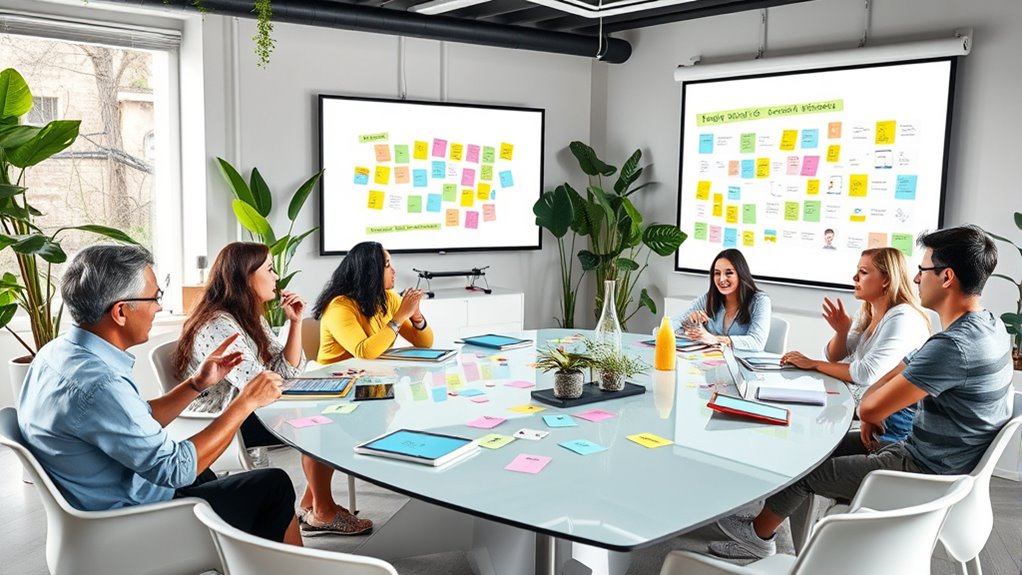
As collaboration shifts toward digital tools, finding ways to keep participants engaged without relying on paper or sticky notes becomes increasingly important. Eco-friendly facilitation encourages mindful engagement by leveraging interactive platforms that promote active participation. Use real-time polls, chat functions, and collaborative online documents to gather input and foster dialogue. Break participants into small virtual groups to encourage deeper discussion, and incorporate visual tools like shared mind maps or virtual whiteboards. These strategies reduce waste and keep energy focused on ideas rather than materials. Additionally, understanding hours of operation for various retail outlets can help in planning workshop logistics around participants’ availability. As you facilitate, emphasize mindful engagement by checking in regularly and inviting diverse perspectives, ensuring everyone feels heard. This approach not only minimizes environmental impact but also creates a more inclusive, dynamic workshop experience.
Creative Techniques for Visualizing Ideas Virtually
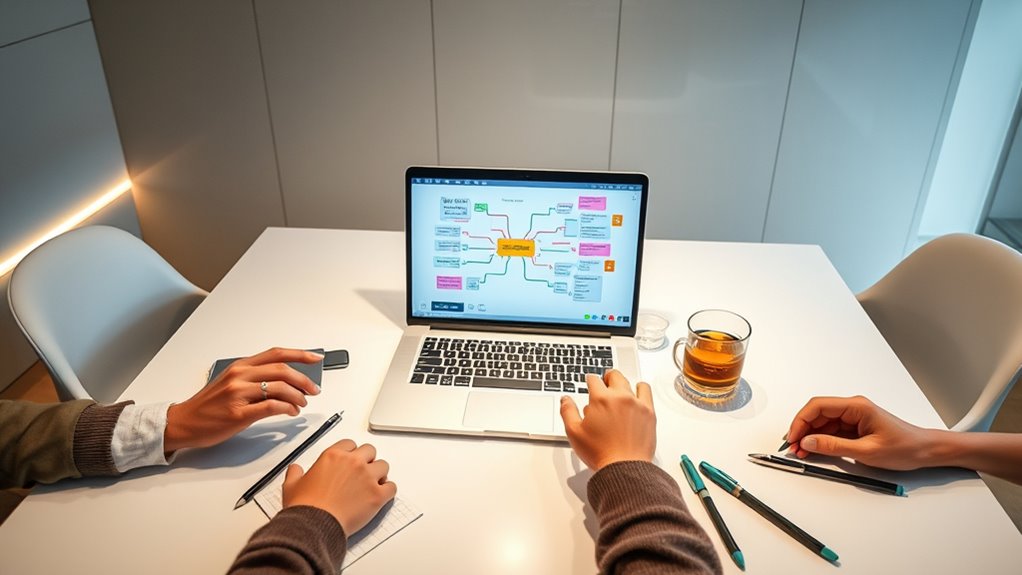
You can bring your ideas to life quickly with digital sketching tools that let you draw and brainstorm freely. Interactive virtual whiteboards also enable real-time collaboration, making it easy to organize thoughts visually. These techniques help you visualize concepts clearly without wasting any paper or materials. Being aware of grocery store hours can also help you plan your workshops more effectively, ensuring participants have ample time to contribute.
Digital Sketching Tools
When exploring creative techniques for visualizing ideas virtually, digital sketching tools offer a versatile and efficient solution. With digital tools like sketching apps, you can quickly capture ideas, refine concepts, and share visuals in real-time. These tools provide a range of brushes, colors, and layers, allowing you to experiment without waste or restrictions. They foster collaboration, as team members can contribute simultaneously, making remote workshops more interactive. Unlike traditional methods, digital sketching reduces the need for physical materials, supporting zero waste principles. Plus, you can access your sketches anytime, anywhere, keeping ideas organized and easily adjustable. Using sketching apps streamlines your workshop process, encourages creativity, and minimizes environmental impact—all while making virtual collaboration seamless. Additionally, adopting digital sketching aligns with zero waste initiatives by reducing paper and material consumption.
Interactive Virtual Whiteboards
Interactive virtual whiteboards have revolutionized how teams brainstorm and visualize ideas in real-time. They eliminate the need for paper alternatives and physical materials, reducing waste and streamlining collaboration. With features like sticky notes, drawing tools, and multimedia integration, you can easily organize concepts without clutter or disposables. These platforms enable participants to contribute simultaneously, fostering dynamic engagement regardless of location. You can create diagrams, flowcharts, and mind maps effortlessly, making ideas clearer and more accessible. Plus, since everything is stored digitally, there’s no need for printing or physical storage. This shift not only saves resources but also encourages eco-friendly practices. Incorporating natural materials and rustic decor into your physical workspace can further reinforce sustainable practices. Using interactive virtual whiteboards helps you run zero waste workshops, promoting sustainable ideation while maintaining creativity and productivity.
Structuring Sessions to Maximize Sustainability and Productivity
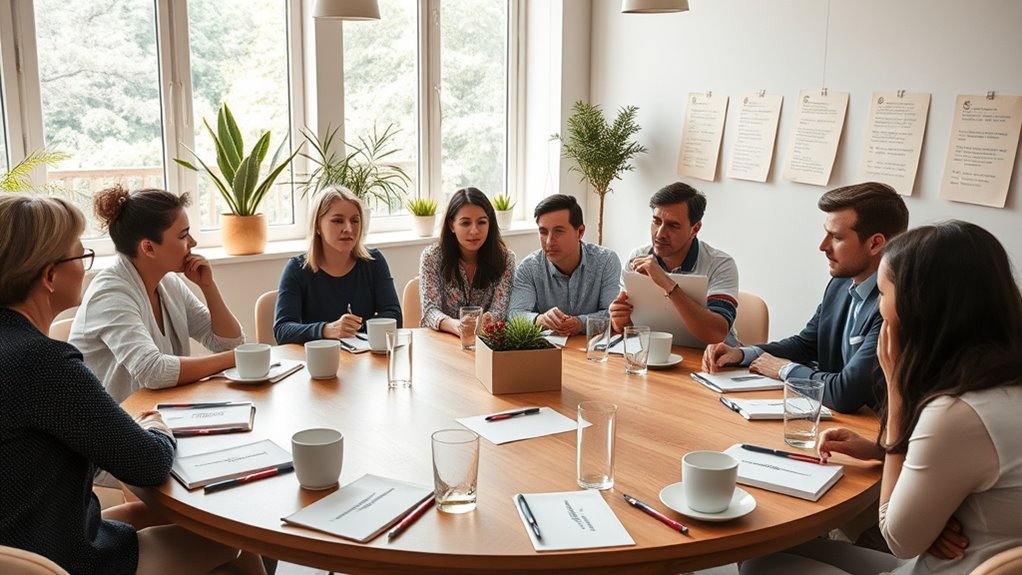
To maximize both sustainability and productivity in zero waste workshops, it’s essential to design sessions that are well-structured and purpose-driven. Use eco-friendly materials, such as digital tools or reusable resources, to minimize waste and set a sustainable tone from the start. Incorporate waste reduction strategies by planning activities that avoid single-use items and unnecessary printing. Clearly outline your agenda, focusing on essential topics to keep sessions focused and efficient. Allocate time for discussion and reflection, ensuring every activity aligns with your sustainability goals. By intentionally structuring your workshop, you foster an environment where participants remain engaged without excess waste. Additionally, emphasizing emotional support techniques can help participants feel more connected and motivated to adopt sustainable practices, creating a more impactful experience. This approach helps maximize impact while staying true to zero waste principles.
Encouraging Inclusive Participation and Diverse Perspectives
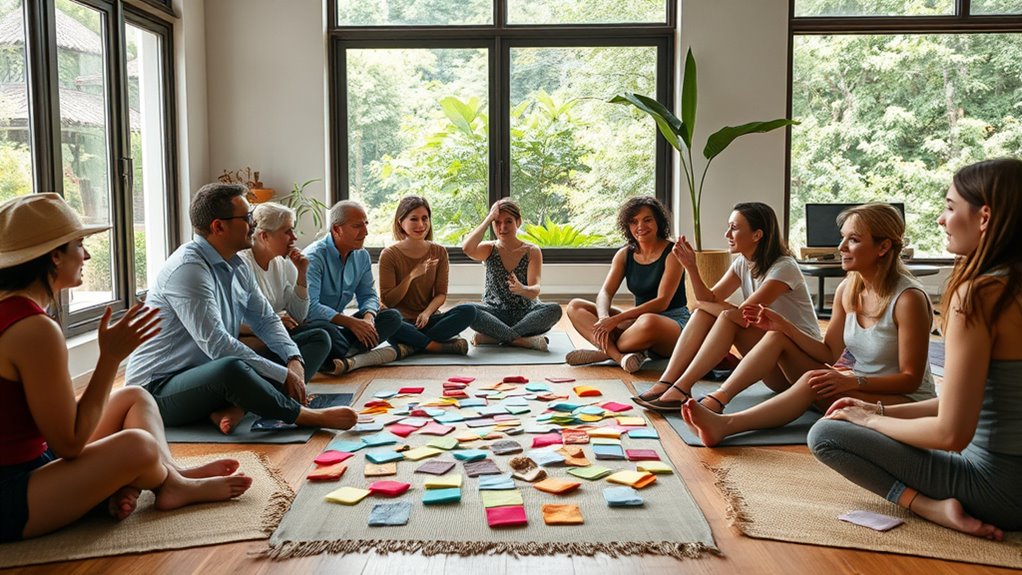
You can create a more effective workshop by ensuring everyone has an equal voice and feels comfortable sharing their ideas. Embracing diverse perspectives brings fresh solutions and strengthens your community. When you actively encourage participation from all backgrounds, your zero waste efforts become truly inclusive. Additionally, understanding global economic outlooks can help tailor initiatives that resonate across different communities and foster broader engagement.
Foster Equal Voice
Creating an inclusive environment in zero waste workshops guarantees that everyone’s voice is heard and valued. You foster this by practicing inclusive facilitation, which actively encourages participation from all attendees, regardless of background or confidence level. Make sure that each person has an opportunity to contribute, whether through direct questions or by inviting quieter participants to share their thoughts. Use techniques that promote equitable participation, like round-robin sharing or small group discussions, avoiding dominance by a few voices. By consciously balancing participation, you create a space where diverse perspectives thrive. This approach not only enriches the conversation but also strengthens collective commitment to zero waste goals. An environment of equal voice empowers everyone to feel involved, respected, and motivated to contribute meaningfully. Incorporating inclusive facilitation techniques ensures that all individuals feel comfortable and confident in sharing their ideas.
Embrace Varied Ideas
Embracing varied ideas is essential for fostering an inclusive zero waste workshop environment. When you actively seek mindful diversity, you open the door for different perspectives that can spark innovative solutions. Encourage participants to share their unique experiences and insights without fear of judgment, promoting inclusive collaboration. This approach guarantees everyone feels valued and heard, enriching the conversation with a broader range of ideas. By making space for diverse viewpoints, you create a dynamic environment where creativity thrives. Remember, no single idea is the whole answer—it’s the combination of varied input that drives meaningful progress. Emphasizing inclusivity and diversity helps build a collaborative atmosphere that’s resilient, innovative, and truly representative of all voices involved. Incorporating diverse ideas enhances the effectiveness of your initiatives and fosters a more comprehensive understanding of the issues at hand.
Measuring Success and Continuous Improvement in Zero Waste Workshops
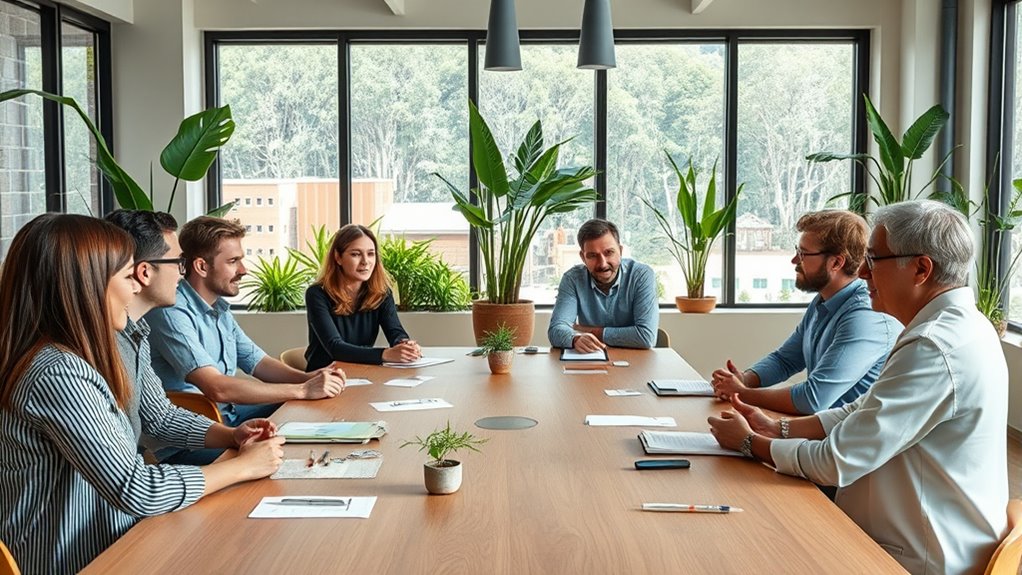
How can organizers effectively gauge the impact of their zero waste workshops and identify areas for growth? The key is establishing clear success metrics and implementing feedback loops. Success metrics might include participant engagement, knowledge gained, and behavior changes over time. Collect feedback through surveys, verbal check-ins, or digital forms—these create feedback loops that help you understand what’s working and what isn’t. By analyzing this data regularly, you can refine your approach, adjust activities, and set measurable goals for continuous improvement. Remember, success isn’t static; it evolves with your community’s needs. Tracking progress through specific metrics keeps your workshops focused and impactful, ensuring you make meaningful strides toward zero waste practices.
Frequently Asked Questions
How Can Zero Waste Workshops Ensure Creative Spontaneity Without Physical Tools?
You can foster creative spontaneity in zero waste workshops by leveraging digital tools that promote virtual creativity. Use online collaboration platforms like Miro or Jamboard to enable participants to brainstorm and share ideas spontaneously. Incorporate real-time voting and interactive exercises to keep energy high. This approach encourages dynamic engagement, ensuring that virtual creativity thrives without physical tools, making your workshop more innovative and environmentally friendly.
What Are the Best Ways to Handle Technical Issues During Digital Ideation Sessions?
When facing technical issues during digital ideation sessions, you should prepare for technical troubleshooting by having a clear plan for common problems. Guarantee your digital connectivity is stable and test your tools beforehand. If issues arise, stay calm, communicate with participants, and switch to backup methods like phone calls or offline notes if needed. Quick, proactive responses keep your session productive and help maintain creative flow.
How Do You Maintain Participant Engagement in Virtual Workshops Over Extended Periods?
To keep participants engaged in long virtual workshops, you should incorporate interactive polling to involve everyone actively. Breakout sessions allow smaller group discussions, making engagement easier and more dynamic. Mix activities frequently to maintain energy and focus, and use visual aids to keep ideas clear. Your goal is to make the experience participatory and varied, ensuring attendees stay motivated and connected throughout the session.
Can Zero Waste Workshops Be Adapted for Large or Remote Teams Effectively?
Think of scaling strategies for remote facilitation as planting seeds that grow into a thriving forest. You can adapt zero waste workshops for large or remote teams by leveraging digital tools that foster interaction without waste. Use breakout rooms, live polls, and collaborative platforms to engage everyone actively. These methods guarantee your workshops are impactful and inclusive, even at scale, turning remote teams into a connected, eco-conscious community.
How Do You Validate Ideas Generated Without Traditional Brainstorming Methods?
When validating ideas without traditional brainstorming, you should use mind mapping to organize and visualize concepts clearly. Engage your peers for validation, asking for feedback and insights to guarantee ideas are practical and impactful. This collaborative approach helps refine concepts efficiently, encourages diverse perspectives, and confirms ideas’ feasibility without relying on sticky notes or other physical tools, ensuring your validation process remains dynamic and inclusive.
Conclusion
By embracing digital tools and creative techniques, you can run engaging, sustainable workshops without any waste. Remember, “a journey of a thousand miles begins with a single step,” so start small and keep innovating. Your efforts not only protect the environment but also foster inclusive, productive discussions. With each zero waste workshop, you’re proving that sustainability and collaboration go hand in hand—making a positive impact, one idea at a time.
